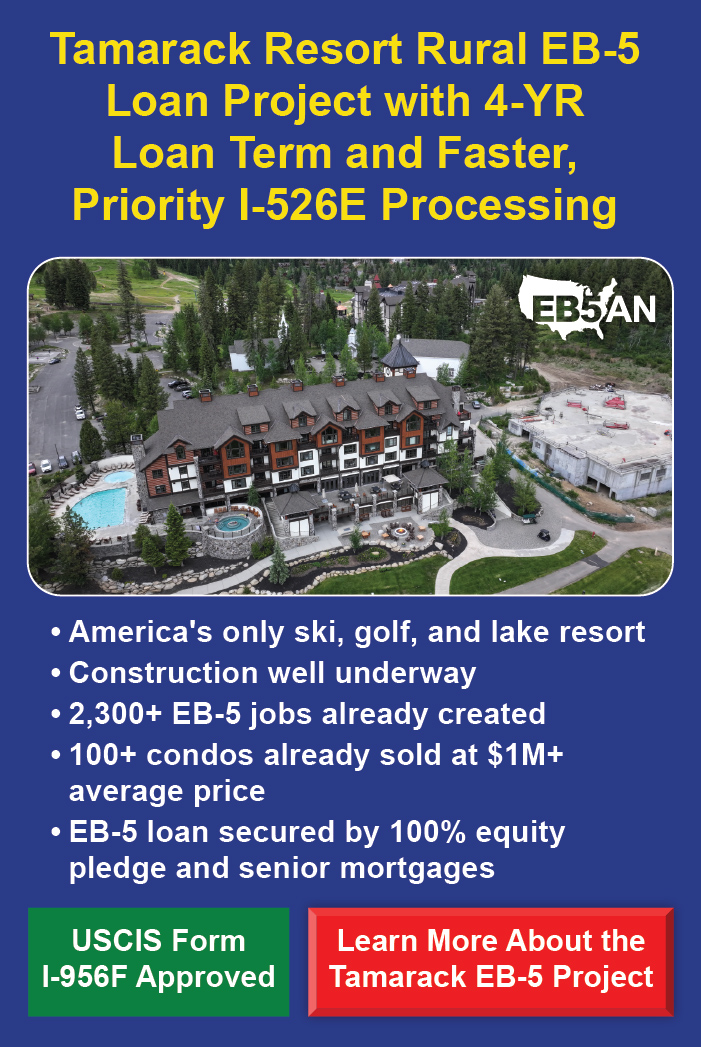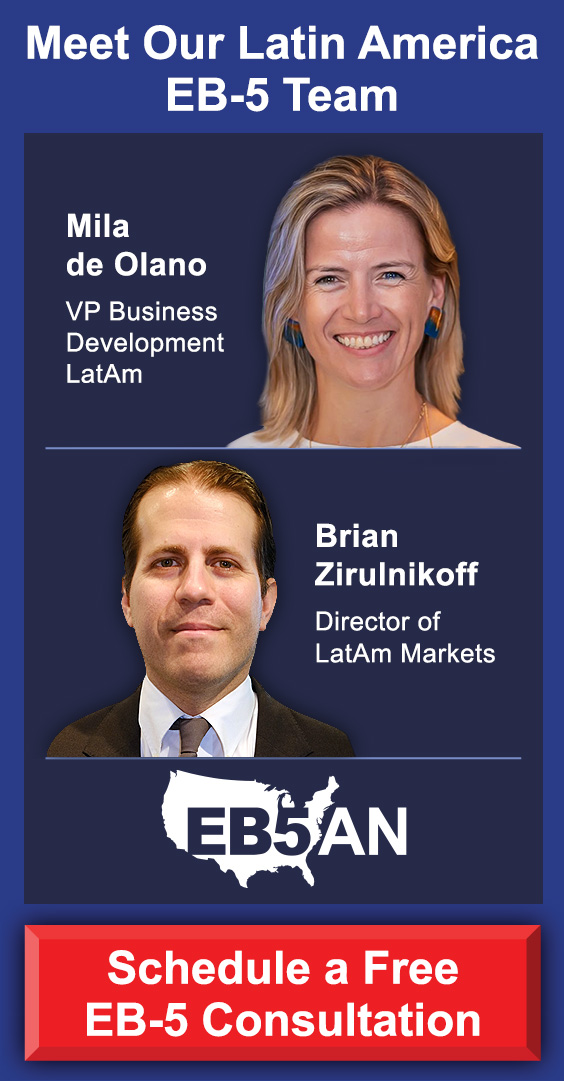The EB-5 Immigrant Investor Program is one of the fastest and most reliable ways for foreign nationals and their spouse and unmarried children under the age of 21 to obtain U.S. green cards.
The program is administered by United States Citizenship and Immigration Services (USCIS), with the aim of encouraging economic growth through capital investment and job creation.
The past two years have seen many changes to the EB-5 Program, largely due to the EB-5 Reform and Integrity Act of 2022 which was passed on March 15, 2022.
Among many new regulations, this legislation reauthorized the EB-5 Regional Center Program through to September 30, 2027, and updated several immigration regulations.
In this article, we will cover everything foreign nationals need to know about the costs of obtaining U.S. green cards for themselves and their qualifying family members through the EB-5 Visa Program.
Here’s what we’re going to cover:
What Is a Conditional vs a Permanent Green Card?
What Is an EB-5 Investment?
What Is the EB-5 Minimum Investment Required in 2024?
What Are the Costs Related to the EB-5 Program?
How Much Is the EB-5 Visa Petition Filing Fee?
How Much Is the EB-5 Visa Adjustment of Status Processing Fee?
How Much Is the EB-5 Visa I-829 Application Processing Fee?
What Does An EB-5 Visa Immigration Attorney Charge?
Helpful Resources
Secure Your Future in the U.S. with EB5AN
What Is a Conditional vs a Permanent Green Card?
Once an EB-5 investor’s I-526E petition has been approved, the investor may enter the U.S. on an Immigrant Visa (EB-5 Visa), and live and work in the U.S. on a conditional green card that is issued on arrival.
After the two-year conditional residency period, the investor will submit an I-829 petition to have the conditional status removed. The two key conditions are (i) a minimum of 10 U.S. jobs must have been created by the investment, and (ii) the investment must have been sustained for a minimum two-year period, with such two-year period commencing at the time dictated by USCIS policy guidance then in effect. Once the I-829 petition is approved, the conditional status is removed, and the investor can enjoy the benefits of a permanent Green Card.
The EB-5 Program—like all U.S. immigrant visas—is administered by USCIS, the federal government agency in charge of immigration visas. This means that the EB-5 Visa is “employment-based” and is the fifth preference within that category.
Other categories of employment-based visas include, inter alia:
- Workers of extraordinary ability.
- U.S. foreign service employees.
- Multinational executives.
An EB-5 Visa does not require a visa sponsor, such as an employer or educational institution. Investors and their spouses and unmarried children under the age of 21 are free to live, work, and study anywhere in the U.S. without restriction.
They can change jobs, receive social welfare benefits, and even travel internationally without losing their immigration status. An EB-5 investor visa is granted in two stages: two-year conditional permanent residency and permanent residency without conditions.
After having made the EB-5 minimum investment in a new commercial enterprise (NCE), investors and their family members can apply for conditional residency status. Conditional residency status lasts two years. During this initial conditional residency, the investment must be kept at risk, and the required minimum jobs must be created and sustained.
At the end of the two-year conditional permanent residency period, EB-5 investors apply to remove conditions from their immigration visas. Once this application has been approved, they will be granted permanent U.S. green cards without conditions.
Green card holders can then apply for U.S. citizenship after five years of U.S. permanent residence.
Summary of EB-5 Visa Requirements
When you apply for an EB-5 Visa through a regional center, these are the key requirements that you must meet to be eligible for a green card:
- Proof of investment with a minimum capital amount of $1,050,000, or $800,000, if the investment is an infrastructure project or located in a rural or high-unemployment targeted employment area (TEA).
- Proof of lawful source of funds.
- Funds must be invested in an NCE.
- Create a minimum of 10 full-time jobs.
- The capital investment must be at risk.
- Any foreign business registration documents must be presented at your petition filing date.
It’s also important to note that this investment must be made within the U.S. and approved by USCIS. We’ll discuss this in more detail in the next section.
What Is an EB-5 Investment?
An EB-5 investment is a capital investment in a project or business venture that meets all the requirements of the EB-5 Program. This investment allows the foreign national to qualify for lawful permanent residency in the United States.
Foreign investors must invest in a job-creating entity (JCE) via an NCE, in the U.S., which is referred to as the investor’s EB-5 project.
The investment capital must also be lawfully sourced and be “at-risk” for at least two years. This means that the investment is real and without a guarantee of return.
The invested capital has to be used to create a minimum of 10 full-time jobs for U.S. workers. These full-time job positions must last a minimum of two years.
There are two types of EB5 investment: direct investments and regional center investments. A direct EB-5 investment requires the employment of workers that can be taxed, whilst an indirect EB-5 investment utilizes the creation of indirect jobs through construction expenditure and/or operational income. The indirect EB-5 investor has a limited role in the NCE, whilst the direct EB-5 investor has a more active role in the management of the NCE.
Both investments have their own appeals and drawbacks that we’ll take a closer look at in the next section.
Direct EB-5 Investment
A direct investment is where an EB-5 investor invests directly in a JCE via an NCE.
Direct investments in NECs are often riskier than regional center projects and require investors to take more hands-on responsibility in the day-to-day management of the NCE.
EB-5 investors who invest directly can only count direct jobs toward their job creation requirement. Direct jobs are types of employment created as a direct result of the project.
For example, if you start a courier service, direct jobs would be the drivers of the trucks and the staff who pack the boxes.
Indirect Regional Center EB-5 Investment
A regional center investment is when an investor indirectly invests in an NCE through a USCIS-approved EB-5 regional center.
Regional centers pool investment money from multiple EB-5 investors to aid the funding of larger and less risky projects. These types of EB-5 investors can count direct jobs, indirect jobs, and induced jobs toward their required minimum of 10 full-time jobs for U.S. workers.
This expands the possibilities for counting jobs created beyond the NCE itself to jobs created or preserved in the community, such as vendors, tenants, suppliers, and more.
This increased flexibility is one of the primary reasons why nearly all successful EB-5 Visa candidates choose to invest through a regional center.
What Is the EB-5 Minimum Investment Required in 2024?
In 2024, the EB-5 minimum capital investment is $800,000, but only if the chosen project or business venture is an infrastructure project or located in a targeted employment area (TEA).
For any other investment, the minimum EB-5 investment amount is $1,050,000.
A TEA is a rural area or location with a high unemployment rate of at least 150% above the national average. Projects in TEA locations allow for a lower minimum investment to encourage economic development in underserved communities in the United States.
What Are the Costs Related to the EB-5 Program?
There are many costs involved with the EB-5 Immigrant Investor Program, in addition to the foreign investment amount itself. Remember that the minimum EB-5 Visa investment is $800,000 for infrastructure or TEA projects and $1,050,000 for all other projects.
Other costs associated with the EB-5 Visa Program can largely be broken down into three categories:
- Administrative costs s.
- USCIS petition filing fees.
- EB-5 immigration lawyer fees.
USCIS filing fees can be found on the USCIS website by accessing this link.
Administrative costs and immigration attorney fees vary widely between various regional centers, law firms, and EB-5 projects. Other fees may include money transfer fees, report compiling fees, and mailing costs.
How Much Is the EB-5 Visa Petition Filing Fee?
After making the required investment in a qualifying commercial enterprise, foreign investors will either file:
- Form I-526—Immigrant Petition by a Standalone Investor—for those who made a direct investment, or
- Form I-526E—Immigrant Petition by a Regional Center Investor—if they invested through an EB-5 regional center.
An I-526 petition and its supporting documentation are used to prove to USCIS that the investor has made a qualifying EB-5 investment and demonstrate the likelihood of the investment meeting the job-creation requirements.
The filing fees for Form I-526 and I-526E can be found on the USCIS fee page by accessing this link.
The EB-5 Reform and Integrity Act of 2022 requires all EB-5 regional center investors to submit an additional $1,000 fee with their I-526E application. This fee supports the EB-5 Integrity Fund in the U.S. Treasury.
How Much Is the EB-5 Visa Adjustment of Status Processing Fee?
An EB-5 investor who resides in the U.S. on another employment-based visa at the time of filing may concurrently file for an adjustment of status to allow the investor to remain in the U.S. whilst their petition is pending adjudication.
Once an investor’s I-526 or I-526E petition has been approved, they will be granted conditional permanent resident status to live in the United States for two years. They must, before this period lapses, file Form I-829 to have the conditions removed on their conditional Green Card and become permanent residents by holding a permanent Green Card.
Form I-485—Application to Register Permanent Residence or Adjust Status—has a processing fee for all persons over the age of 14 and $750 for children under the age of 14.
The EB-5 Reform and Integrity Act of 2022 allows foreign nationals already legally residing in the U.S. on a different visa to file Form I-526, I-526E, and Form I-485 simultaneously. A biometrics service fee is also required of each applicant.
How Much Is the EB-5 Visa I-829 Application Processing Fee?
Within the last 90 days of the two-year conditional permanent residency, investors must file Form I-829—Petition by Investor to Remove Conditions on Permanent Resident Status. This form proves that the EB-5 investment has fulfilled all of the program’s requirements, specifically regarding job creation and sustaining the investment ‘at risk’ for the minimum required two-year period.
The filing fee for Form I-829 can be found on the USCIS fee page by accessing this link [INSERT LINK]. Once this petition has been approved, EB-5 investors will be issued permanent, unconditional U.S. Green Cards, which grant them lawful permanent resident status.
What Does An EB-5 Visa Immigration Attorney Charge?
Immigration attorney legal fees usually start from $20,000.
The EB-5 process is very complex and involves intricate supporting documentation that can be difficult to prepare. Successfully navigating the pitfalls and shortcuts of the EB-5 Program is a time-consuming process for even the most experienced EB-5 immigration lawyers.
Although EB-5 immigration attorney fees may seem high, an experienced lawyer can speed up the application process, which saves investors time and money. They can also advise on the exact supporting documentation required at each stage of the EB-5 process, which will help you file your forms successfully.
Helpful Resources
Secure Your Future in the U.S. with EB5AN
The EB-5 application can be a challenging process if you don’t know where to start. That’s why EB5AN is here to help you choose a low-risk EB-5 project.
EB5AN is a leading national EB-5 consulting firm and one of the largest regional center operators in the United States. EB5AN owns and operates 15 regional centers covering the entire continental United States. The firm currently sponsors over 2,300 EB-5 investors in EB-5 projects nationwide.
Working with the EB5AN can also reduce an investor’s stress and uncertainty as the firm offers high-quality, low-risk, rural, and high-unemployment TEA projects for investment. EB5AN’s current investment opportunities can be accessed via this link.
For more information on regional center investment opportunities that are available now, contact EB5AN today.









